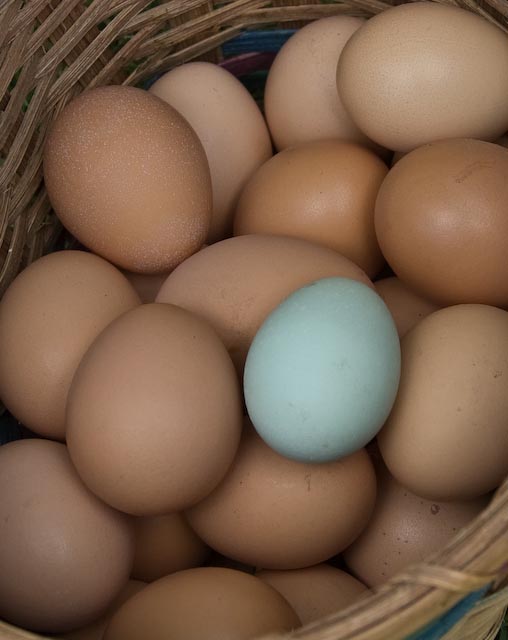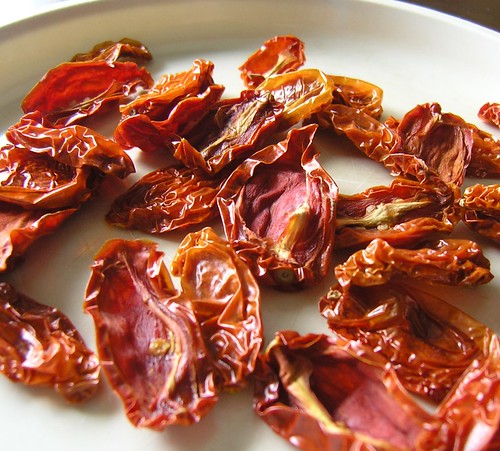

I'm a green mom, as well as an herbalist and holistic healer with over 15 years of experience. I write about gardening, green living, natural healing, good food, a bit of this, and a bit of that. Enjoy!


 Sometimes, the best way to tackle a problem is sideways, rather than head on.
Sometimes, the best way to tackle a problem is sideways, rather than head on. We drink a gallon of milk a week, fresh from the farm. The farmer brings us our milk in recyclable gallon plastic jugs, which pile up until I can get to the recycling center. They are big, and they are unsightly. They get on my nerves.
We drink a gallon of milk a week, fresh from the farm. The farmer brings us our milk in recyclable gallon plastic jugs, which pile up until I can get to the recycling center. They are big, and they are unsightly. They get on my nerves.


 I am the happy owner of a very intelligent, family-bred AKC-registered dog. She is descended from champions. She is a Standard Poodle. She requires regular grooming. And, alas, she does not go to the same groomers who made her parents champions. No. She goes to me. Or, more accurately, my table.
I am the happy owner of a very intelligent, family-bred AKC-registered dog. She is descended from champions. She is a Standard Poodle. She requires regular grooming. And, alas, she does not go to the same groomers who made her parents champions. No. She goes to me. Or, more accurately, my table.  How DO sheep shearers do it so quickly? My clippers were barely up the task, even with new blades.
How DO sheep shearers do it so quickly? My clippers were barely up the task, even with new blades.
Afternoon sun through the trees in the nature preserve bordering our land. Is that a fairy-vision on the left?

This is the first day the pool has been thawed out since the fall. We emptied it a few times then, but it always filled up with rain somehow before we could put it away for the winter. Lucas thinks it's just the spot to go fishing this year. If you around my property, you may surprised to see a lot of big plastic toys for Lucas to play with: slides, gyms, tables, baby mowers, trucks, the pool, etc. Almost every single outdoor toy came from "freecycling" (bulk trash pickup week in our town). I try to do my part by keeping the plastic out of the landfills as long as possible, and getting the most use out of them: Lucas, of course, is happy to oblige!

Rhubarb is one of the first edibles to appear in my yard in Spring. This ancient plant produces shoots all summer long. No matter what, we will never have scurvy!

An old wise man holding the "Seed of Longevity" keeps an eye over this bed of tulips and periwinkle. Last year, I moved the peonies that lived here to another spot. At least, I think I did! Seems awfully early for tulips...

Lady's Mantle (Top) and more tulips (Bottom). Lemon Balm and oregano are also making a show nearby on either side in the herb garden. You may ask, what are tulips doing in the herb garden? And I say unto you: flowers go whither they will. Even the nicest herb garden is, well, a little green. I can't resist putting flowers in with my herbs...And many of my perennial flowers in the "flower garden" are medicinal herbals, too.

Farmer Luke, digging for rocks. He especially likes putting the rocks from the paths into the garden beds, and the mulch from the beds in the paths. Fun!

Spinach seedlings, finally making an appearance.
 These days a lot of power distribution companies offer the choice to shop around. You can choose a supplier co-op, who shops for and supplies the cheapest energy that month. You can choose a supplier who uses only wind energy, or hydro and landfill gas. You can choose local power. Every state has different options, but almost everyone these days is offering some options.
These days a lot of power distribution companies offer the choice to shop around. You can choose a supplier co-op, who shops for and supplies the cheapest energy that month. You can choose a supplier who uses only wind energy, or hydro and landfill gas. You can choose local power. Every state has different options, but almost everyone these days is offering some options. We've all heard about Global Warming or Climate Change. And there is no question that our human ways are polluting the earth...but are we really causing the bulk of global warming? And is global warming even still taking place? There are quite a few scientists who say no. Solar and Space scientists, in particular, have a lot to say on the topic. Mars has been losing its polar ice caps at the same rate as the earth, while solar activity was higher than normal over the last several decades. Some people think this is a clear indicator that the phenomenon is solar-related, and not based primarily on human activities.
We've all heard about Global Warming or Climate Change. And there is no question that our human ways are polluting the earth...but are we really causing the bulk of global warming? And is global warming even still taking place? There are quite a few scientists who say no. Solar and Space scientists, in particular, have a lot to say on the topic. Mars has been losing its polar ice caps at the same rate as the earth, while solar activity was higher than normal over the last several decades. Some people think this is a clear indicator that the phenomenon is solar-related, and not based primarily on human activities.  6 years ago, my aunt gave me a cookbook for Christmas titled simply, "Chicken." She had no idea that this book, which was published by the restaurant she managed, would begin a long term obsession with owning my own small poultry flock. I own many, many cookbooks, and none ever held my attention the way this one did. It had recipes for chicken and eggs, but it also had poultry lore, facts and tidbits, along with gorgeous oversize photos of different chicken breeds. It was here that I learned about Araucanas, the blue-green egg-layers, and Leghorns, Javas, Sumatras and Bantams, to name a few.
6 years ago, my aunt gave me a cookbook for Christmas titled simply, "Chicken." She had no idea that this book, which was published by the restaurant she managed, would begin a long term obsession with owning my own small poultry flock. I own many, many cookbooks, and none ever held my attention the way this one did. It had recipes for chicken and eggs, but it also had poultry lore, facts and tidbits, along with gorgeous oversize photos of different chicken breeds. It was here that I learned about Araucanas, the blue-green egg-layers, and Leghorns, Javas, Sumatras and Bantams, to name a few. Raven
Raven  Remember those old Tupperware ice pop makers? I lived on them as a child, so when my baby first learned the words "ice cream" I went straight on eBay and bought a dozen. Now Lucas can eat "ice cream" as much as he wants, because I know it's full of only healthy things like yogurt or leftover whey protein from cheese making with a little juice. The last batch I made was probably the best one yet, and I figured I would share it with you.
Remember those old Tupperware ice pop makers? I lived on them as a child, so when my baby first learned the words "ice cream" I went straight on eBay and bought a dozen. Now Lucas can eat "ice cream" as much as he wants, because I know it's full of only healthy things like yogurt or leftover whey protein from cheese making with a little juice. The last batch I made was probably the best one yet, and I figured I would share it with you. This month promises to be a busy one, while I prepare to move my store a half-mile down the road to a new, bigger location. We have doorways to install, rooms to paint, electricity and Internet to turn on, and signs to get approved. It's all a little daunting, since business has been a little slow lately, but this location gets a lot more traffic and our landlord is going to charge us the same amount of rent for a bigger space, so its a bit of a no brainer. Here, we'll be offer to more services, including yoga and chi kung. If we can't make it here, we wouldn't have made it anywhere.
This month promises to be a busy one, while I prepare to move my store a half-mile down the road to a new, bigger location. We have doorways to install, rooms to paint, electricity and Internet to turn on, and signs to get approved. It's all a little daunting, since business has been a little slow lately, but this location gets a lot more traffic and our landlord is going to charge us the same amount of rent for a bigger space, so its a bit of a no brainer. Here, we'll be offer to more services, including yoga and chi kung. If we can't make it here, we wouldn't have made it anywhere. Discoveries like this get me really excited. While many of us are trying to reduce our energy usage and wanting to be greener, a lot of times it's just not very easy. While I know that there are certain behaviors that we can adjust to reduce are carbon footprint, I think the real key to change in America, and the world, lies in new technology and innovations.
Discoveries like this get me really excited. While many of us are trying to reduce our energy usage and wanting to be greener, a lot of times it's just not very easy. While I know that there are certain behaviors that we can adjust to reduce are carbon footprint, I think the real key to change in America, and the world, lies in new technology and innovations.  Finding produce that is local, organic and/or non-genetically modified at the grocery can be very difficult, not to mention time consuming as you turn little pieces of fruit over trying to find the tiny print that says where it was grown and what it is. Sometimes, it doesn't say. But you know those stickers with numbers on them that you always have to peel off? Well, turns out they actually tell you how the food was grown.
Finding produce that is local, organic and/or non-genetically modified at the grocery can be very difficult, not to mention time consuming as you turn little pieces of fruit over trying to find the tiny print that says where it was grown and what it is. Sometimes, it doesn't say. But you know those stickers with numbers on them that you always have to peel off? Well, turns out they actually tell you how the food was grown. Some of you may have noticed that my list of "things to do" in my sidebar included building a solar cooker. This item was born out of scientific interest rather than a real desire to cook in one. In the summer I cook very little, eating mostly fresh raw foods, and in the winter we get almost no direct sun on our property, except our roof, so that when I would like to use a solar cooker for soups and stews, I can't. So I viewed building a solar cooker as more of an experiment, and not something I would use much.
Some of you may have noticed that my list of "things to do" in my sidebar included building a solar cooker. This item was born out of scientific interest rather than a real desire to cook in one. In the summer I cook very little, eating mostly fresh raw foods, and in the winter we get almost no direct sun on our property, except our roof, so that when I would like to use a solar cooker for soups and stews, I can't. So I viewed building a solar cooker as more of an experiment, and not something I would use much. 

